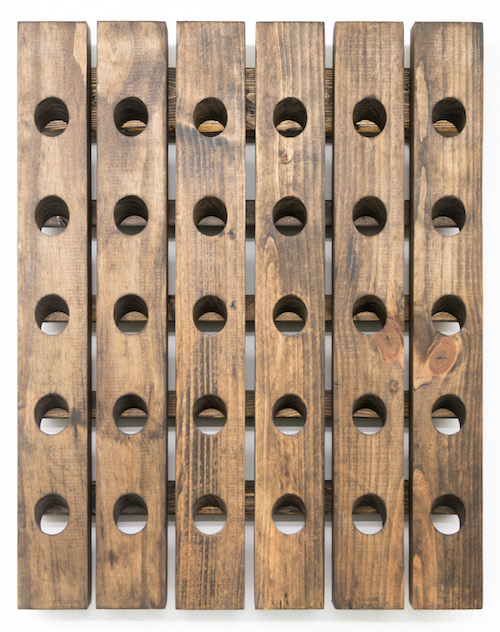Seedless_Grapes_<3
Magnus Andersen
May 6 - June 5, 2016
Opening reception: Friday, May 6, 6 - 9 pm
138 Eldridge Street, New York, NY 10002
PRESS:
Art Viewer
Sex Magazine
PRESS RELEASE:
"It is certainly discouraging to compare the dominant attitude of today with that of the Renaissance, but reflection shows that the change is as inevitable as it is tragic. Individuals with the old instincts must make the best of it through a dream-life of their own..”
H. P. Lovecraft. Letter Clark Ashton Smith. March 15, 1927 How is a return to frame a return to liberty?
When I first noted Magnus Andersen's new frames surrounding the return to the Renaissance we had all been expecting from this most fucked, purchased, omniscient and potentially immortal of all generations -- a rage took ahold of me. A cold, unwielding rejection of frame.
Frame compromises the very contemporaneity of contemporary art. In the very few cases it works, Agnes Martin, for instance, frame comes as solution not statement. Martin's frames are steel and restrained minimalist repetitions, separated from canvas by gulf of darkness -- a void standing for the fear of frame still possessing me.
My father was an abstract artist from a 20th-century New York art scene in which esthetic decision-making was indivisible from morality. He found realism in art decadent and reactionary. When one of his last public commissions contained an eagle's head, I thought the gesture ironic and a sign of growth. He felt shame. He'd done it for the money. Soon later he completed what would be one of his last hand- built sculptures, a five by five slab of two-inch industrial steel force framed by a tree trunk he literally chainsawed, skinned and jointed into place; off the wall the monster painting propped up by a single yellow-painted I-beam. It was a clear moment of sculpture taking a last look at the frame. Clearly Frame had been raised and without (ironically painted) sculpture, would immediately fall again.
And yet here come the frames; like the Triffids claiming all the territories of the landscape; planking, coloring, fencing with all the amateurist naivete of sectarian decorative paintings distinguishing sidewalks in 1980's Belfast. Within territorial bounds, perhaps, the return to real-world skill, the potentially useful craft (can be saved from professionalism) but in the meantime -- rather insultingly disregarding their interior (and Andersen will in fact paint abstract inside as well as out) only the frames take on the politics of freedom, expressing the liberty of self-determining abstraction that the conceptualized compositions have forsaken.
Just as it is freedom from the expanding context of screen (already deeply compromised by the eye of the camera and the corporate logo adorning those unnecessary frames surrounding views like the one of this text I'm typing in Amsterdam 2016) the return to frame may surprisingly display freedom from the 20th century and its various modernist/fascist attempts to implant taste onto politics and vice/versa.
That taste, like Bourdieu says, is still by and large a matter of class, was evidenced by the dialectics of the drum circle and the librarians in Zuccotti Park. Perhaps, like those brave citizens, artists of our future must lead us forward as awkwardly as possible, ambiguities painfully intact, as disinfected fingers in sweaty hand -- we plunge forward into something new, no one quite recognizes. Where, for instance the return to window, to the dreamscape gaze, comes comprimised via some sort of anti-modernist neo-paganism, perhaps via Norse pagan ship-building DNA currently expressing itself in a young pondering Dane's sensitive painting fingers...
The generic, white male faces of our present, eyes alive with dream- without-vision, with only screen and screen below that screen, come within their frames attached, come more as self-written, as Concept, than as skilled articulation. The painter seems to have retreated beneath the surface of illusion. As remote, perhaps, but equally real (it is this immanence the frames fetishize), as the world we see behind us in the mirror is the other-depth of art beyond. All the bubbles of color and materiel rising to froth on the edge of our mirror pool promise plunge. The plunge is painting as commitment.
To be over-honored and over-looked simultaneously must be every artist's fate. But those faces looking back at us from these paintings no longer seem concerned. A dream of their own enlightenment possesses those seedless eyes. After Pollock, only the enormous frame of an idealized and generalized Art structured the painting's depth. The return of frames forces the modern's dégringolade with something like delite. Andersen's works re-birth a personal, where the painting is a singularized and highly- local art event from out of generalis Art. For this viewer, at least, dominated as I am by the regime of the anti-frame, the works have the strange aura of dream catchers, even as they refuse to let dreams go.
Mark von Schlegell











